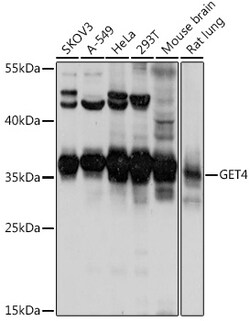Learn More
Invitrogen™ C7orf20 Polyclonal Antibody


Rabbit Polyclonal Antibody
Supplier: Invitrogen™ PA5109762
Description
Immunogen sequence: MAAAAAMAEQ ESARNGGRNR GGVQRVEGKL RASVEKGDYY EAHQMYRTLF FRYMSQSKHT EARELMYSGA LLFFSHGQQN SAADLSMLVL ESLEKAEVEV ADELLENLAK VFSLMDPNSP ERVTFVSRAL KWSSGGSGKL GHPRLHQLLA LTLWKEQNYC ESRYHFLHSA DGEGCANMLV EYSTSRGFRS EVDMFVAQAV LQFLCLKNKS SASVVFTTYT QKHPSIEDGP PFVEPLLNFI WFLLLAVDGG KLTVFTVLCE QYQPSLRRDP MYNEYLDRIG QLFFGVPPKQ TSSYGGLLGN LLTSLMGSSE QEDGEESPSD GSPIELD.
As part of a cytosolic protein quality control complex, the BAG6/BAT3 complex, maintains misfolded and hydrophobic patches-containing proteins in a soluble state and participates in their proper delivery to the endoplasmic reticulum or alternatively can promote their sorting to the proteasome where they undergo degradation (PubMed:20676083, PubMed:21636303, PubMed:21743475, PubMed:28104892). The BAG6/BAT3 complex is involved in the post-translational delivery of tail-anchored/type II transmembrane proteins to the endoplasmic reticulum membrane. Recruited to ribosomes, it interacts with the transmembrane region of newly synthesized tail-anchored proteins and together with SGTA and ASNA1 mediates their delivery to the endoplasmic reticulum (PubMed:20676083, PubMed:28104892, PubMed:25535373). Client proteins that cannot be properly delivered to the endoplasmic reticulum are ubiquitinated and sorted to the proteasome (PubMed:28104892). Similarly, the BAG6/BAT3 complex also functions as a sorting platform for proteins of the secretory pathway that are mislocalized to the cytosol either delivering them to the proteasome for degradation or to the endoplasmic reticulum (PubMed:21743475). The BAG6/BAT3 complex also plays a role in the endoplasmic reticulum-associated degradation (ERAD), a quality control mechanism that eliminates unwanted proteins of the endoplasmic reticulum through their retrotranslocation to the cytosol and their targeting to the proteasome. It maintains these retrotranslocated proteins in an unfolded yet soluble state condition in the cytosol to ensure their proper delivery to the proteasome (PubMed:21636303). [UniProt].
Specifications
| C7orf20 | |
| Polyclonal | |
| Unconjugated | |
| GET4 | |
| 1110007L15Rik; AW412535; C7orf20; CEE; CGI-20; conserved edge expressed protein; conserved edge protein; conserved edge-expressed protein; GET4; golgi to ER traffic protein 4; Golgi to ER traffic protein 4 homolog; golgi to ER traffic protein 4 homolog (S. cerevisiae); H_NH1244M04.5; RGD1311660; Transmembrane domain recognition complex 35 kDa subunit; transmembrane domain recognition complex, 35kDa; TRC35 | |
| Rabbit | |
| Affinity chromatography | |
| RUO | |
| 288518, 51608, 67604 | |
| -20°C, Avoid Freeze/Thaw Cycles | |
| Liquid |
| ELISA, Western Blot | |
| 1.20 mg/mL | |
| PBS with 50% glycerol and 0.01% thimerosal; pH 7.3 | |
| Q7L5D6, Q9D1H7 | |
| GET4 | |
| Recombinant fusion protein containing a sequence corresponding to amino acids 1-327 of human GET4 (NP_057033.2). | |
| 100 μL | |
| Primary | |
| Human, Mouse, Rat | |
| Antibody | |
| IgG |
Your input is important to us. Please complete this form to provide feedback related to the content on this product.
